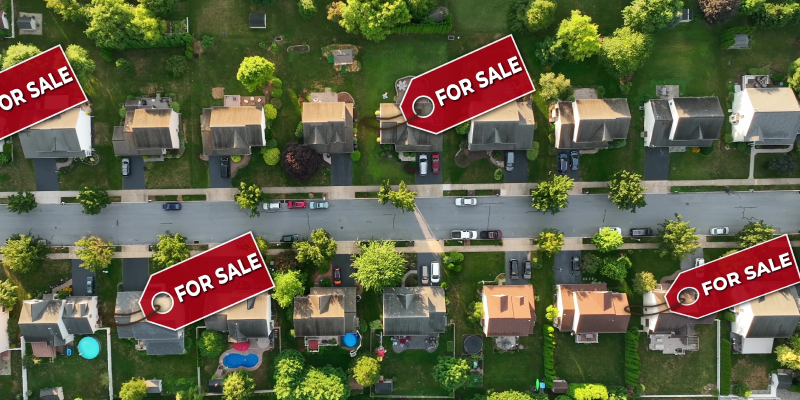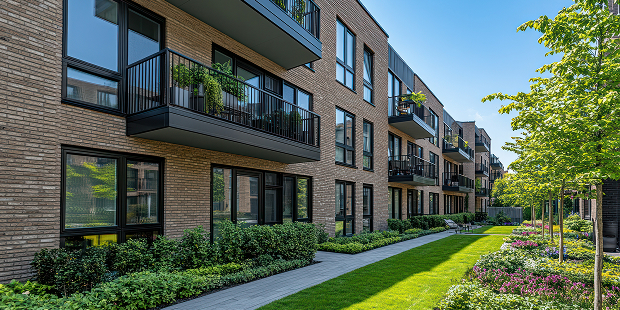The commercial real estate (CRE) sector stands at a pivotal moment. As we move deeper into 2025, shifting economic conditions, evolving tenant expectations, and new capital dynamics are redefining what it means to be successful in this industry. Understanding where the market is—and where it’s headed—is essential for investors, sellers, and operators looking to make strategic, future-ready decisions. At North Star Venture Group, we believe that informed investing is powerful investing. Here’s our take on the current market landscape, the trends shaping the future, and the economic signals we’re watching closely.
1. Resilience Amid Uncertainty: The State of the Market

Despite economic headwinds, commercial real estate is demonstrating notable resilience. After navigating inflation, rising interest rates, and tighter credit over the past 18 months, the market is gradually recalibrating.
Observation 1. Interest Rates May Have Peaked
After an aggressive tightening cycle by the Federal Reserve throughout 2023 and early 2024, the central bank is now signaling a shift. Inflation has shown signs of sustained cooling, and the Fed’s tone has turned more neutral—hinting at potential rate stabilization or modest cuts in the second half of 2025.
What this means for investors:
- Improved borrowing conditions could breathe new life into deal activity, particularly in acquisitions, refinancing, and development.
- Pent-up demand from institutional and private equity capital—which had been waiting for clearer signals—is now beginning to re-enter the market.
- Cap stack recalibrations may become more feasible, as debt becomes more accessible and predictably priced.
While interest rates remain above pre-pandemic levels, even modest easing can unlock liquidity and restore investor confidence.
Observation 2. Cap Rates Remain Elevated—But So Does Opportunity
Cap rates have expanded in most sectors over the last 12–18 months, particularly in secondary and tertiary markets. This reflects both higher financing costs and broader risk aversion.
However, the shift is also revealing mispriced assets and value-add opportunities that savvy investors are beginning to pursue.
Why this matters:
- Sellers are becoming more realistic, creating a narrowing bid-ask spread..
- Investors focused on asset repositioning—including adaptive reuse, ESG upgrades, and operational efficiency—can underwrite deals with compelling upside.
- Distress-driven sales and loan maturities are expected to increase in the coming quarters, particularly in the office and hospitality sectors.
Institutional capital is eyeing this window to acquire at attractive basis points, especially in markets with long-term growth fundamentals.
Observation 3. Flight to Quality Is Driving Performance Divergence
One of the most persistent post-pandemic trends is the “flight to quality.” Tenants across asset classes are gravitating toward newer amenities and well-located properties—even if it means paying a premium.
Here’s what we’re seeing:
- Class A properties in prime locations are commanding higher rents and seeing stronger absorption.
- Well-maintained Class B assets in desirable submarkets—particularly those with upgraded amenities or ESG certifications—are also performing above expectations.
- Distress-driven sales and loan maturities are expected to increase in the coming quarters, particularly in the office and hospitality sectors.
Older, undifferentiated properties in less dynamic markets are facing increased vacancy risk and downward rent pressure.
This bifurcation underscores the importance of asset-level quality and operational excellence. Investors and operators who can identify and elevate underperforming buildings to meet modern standards are well-positioned to outperform in the current environment.
Bottom Line: This Is a market that rewards discipline, creativity, and a long-term lens. The era of easy capital and rapid appreciation is behind us—for now. In its place, we’re seeing a more normalized, fundamentals-driven market emerge.
2. Economic Outlook: Signals for Investors

The broader macroeconomic environment in 2025 is showing signs of cautious optimism. While the journey from post-pandemic volatility to sustained growth is ongoing, the indicators are pointing toward a more balanced, opportunity-rich landscape for commercial real estate.
Observation 1. Inflation Is Cooling—Though Still Above Target
After peaking in 2022 and remaining elevated through 2023, inflation has steadily decelerated, helped by tighter monetary policy, easing supply chains, and softening energy prices. While core inflation remains slightly above the Federal Reserve’s 2% target, the pace of moderation has been consistent, giving policymakers more room to maneuver.
Why it matters for CRE:
- Slowing inflation supports greater pricing predictability in construction materials, labor, and services—essential for development and renovation planning.
- It reduces uncertainty around future interest rate hikes, allowing capital markets to gradually regain stability.
- Tenant operating costs and consumer confidence improve as inflationary pressures ease, supporting healthy leasing activity and rent collections.
The possibility of a “soft landing”—slowing inflation without triggering a recession— is increasingly within reach.
Observation 2. Low Unemployment Supports Demand Across Asset Classes
The labor market has remained remarkably resilient. As of Q1 2025, unemployment remains near historic lows, particularly in sectors tied to professional services, healthcare, logistics, and advanced manufacturing. Wage growth has slowed but remains healthy, and workforce participation is improving.
Implications for real estate:
- Consumer spending remains robust, sustaining demand for retail, hospitality, and service-based industries.
- Steady income levelssupport apartment occupancy and rent growth, particularly in the workforce and market-rate housing segments.
- Employment hubs continue to drive demand for flexible office and hybrid workspace solutions, even as traditional office usage patterns evolve.
This labor strength provides a crucial floor of demand in a market still adjusting to structural shifts.
Observation 3. Capital on the Sidelines Is Ready to Deploy
Private equity firms, institutional investors, and real estate investment funds have spent the last year recalibrating, waiting for clarity on interest rates and asset repricing. With inflation cooling and rate stabilization on the horizon, many are preparing for strategic re-entry.
We’re seeing:
- Dry powder accumulation at record levels, particularly among opportunity and value-add funds.
- Increased interest in off-market deals, distressed assets, and recapitalizations that offer attractive basis and long-term upside.
- A renewed focus on sector diversification, ESG integration, and tech-forward assets to align with evolving investor priorities.
This upcoming deployment wave could catalyze deal flow and improve liquidity across select segments of the CRE market.
Additionally, cities with strong job growth, diversified economies, and favorable business climates—such as Dallas, Raleigh, and Nashville—continue to outperform national averages and offer compelling long-term upside.
3. Capital Markets and Investment Strategy

While the macroeconomic landscape is showing signs of stabilization, liquidity remains uneven across commercial real estate sectors. Traditional lenders are still cautious, and underwriting standards have tightened. However, this environment is not without opportunity—it’s simply shifting who is investing, where capital is flowing, and how deals are getting done.
At North Star Venture Group we see this as a moment that rewards not just access to capital—but insight, creativity, and strategic discipline.
Observation 1. Distressed Assets & Recapitalizations: Dislocation Creates Opportunity
With many owners facing capital stack pressure due to elevated interest rates and maturing debt, we’re seeing a growing number of distressed opportunities, particularly in the office and hospitality sectors. Some properties face occupancy or valuation declines, while others are caught in refinancing gaps.
Where we’re focusing:
- Well-located but undercapitalized assets where smart repositioning can unlock value.
- Recapitalizations and joint ventures with existing ownership groups seeking liquidity or new operational strategies.
- Selective hospitality investments, especially in experiential and boutique segments that can rebound faster with operational improvements.
In today’s climate, distressed doesn’t have to mean dysfunctional—it can mean discounted, and ripe for reinvention.
Observation 2. Adaptive Reuse & Redevelopment: Reimagining What Real Estate Can Be
As space needs evolve, many underperforming properties—particularly in office, retail, and industrial—are being repositioned for higher and better uses. Adaptive reuse is gaining momentum as investors look to reimagine outdated assets for modern demand.
Key trends include:
- Converting obsolete office space , into residential, lab, medical, or creative flex uses.
- Revitalizing aging retail centers into mixed-use destinations with housing, healthcare, and lifestyle amenities.
- Reusing industrial properties in urban cores for last-mile logistics, dark kitchens, or e-commerce micro hubs.
These strategies not only reduce environmental impact through lower embodied carbon—they also tap into underserved segments and unlock strong rental demand in constrained markets.
Observation 3. Proptech & ESG-Aligned Investment: Where Innovation Meets Impact
Even in tighter capital environments, investors are showing a clear appetite for forward-looking assets—particularly those aligned with sustainability, technology, and long-term resilience.
What’s drawing capital:
- Proptech platforms that improve building efficiency, tenant experience, and operational insights.
- ESG-driven assets —including buildings with green certifications, energy-efficient systems, and low-carbon footprints—that meet investor mandates and tenant expectations.
- Smart buildings and IoT-enhanced developments, which appeal to both tenants and capital partners focused on future-proofing portfolios.
Impact-focused funds, pension systems, and family offices are increasingly prioritizing mission-aligned investments that also deliver competitive financial returns.
Our Approach at North Star Venture Group
At North Star Venture Group, we’re not chasing capital—we’re placing it strategically. Our investment thesis is rooted in:
- Deep market analysis to identify secular trends and local dynamics.
- Creative value-add execution through physical renovations, operational upgrades, and repositioning strategies.
- Downside protection through conservative underwriting, diversified income streams, and risk-adjusted acquisition pricing.
We’re focused on opportunities that others might overlook—assets that require vision, not just capital. In a market where agility and insight are more important than ever, our goal is clear: create durable value, deliver strong returns, and position every asset to thrive in the next cycle.

